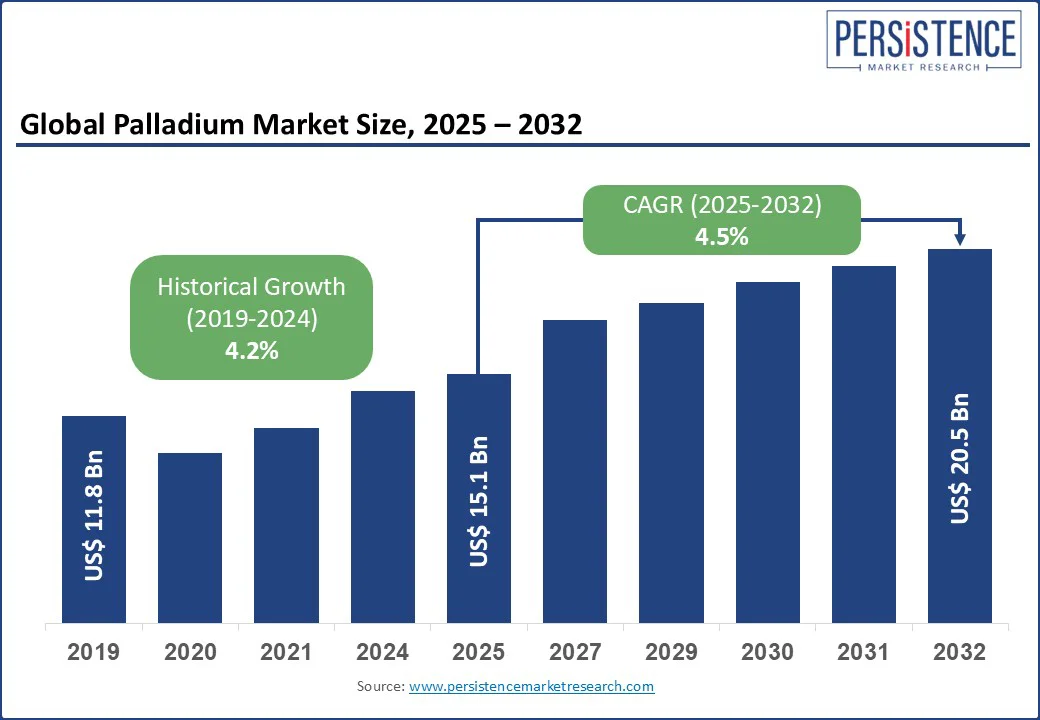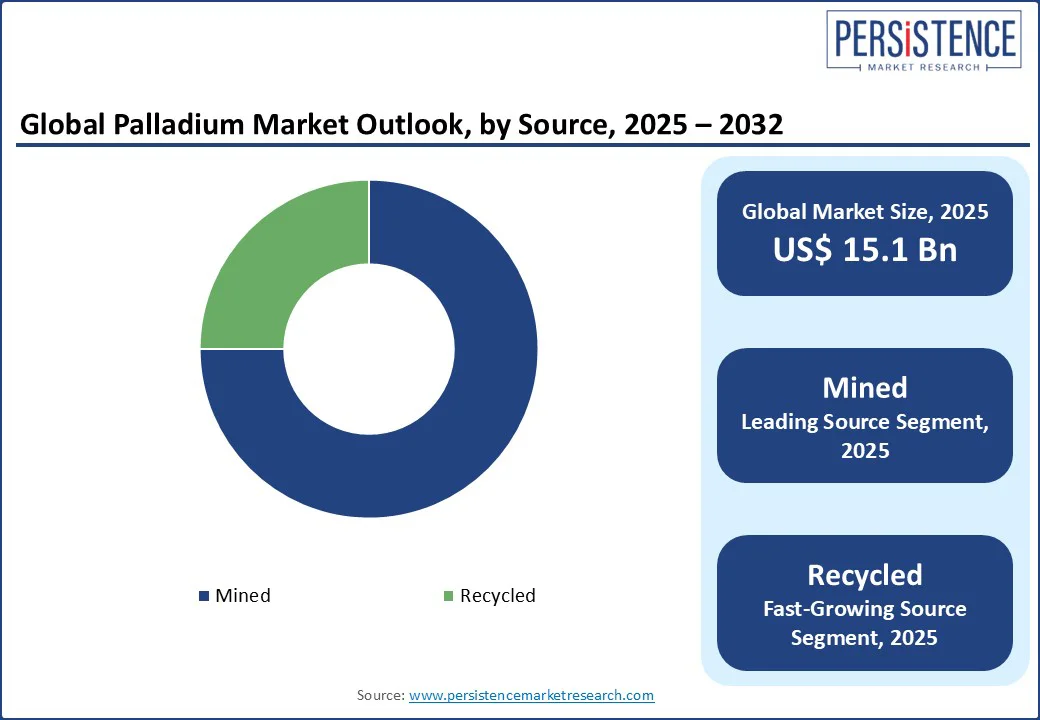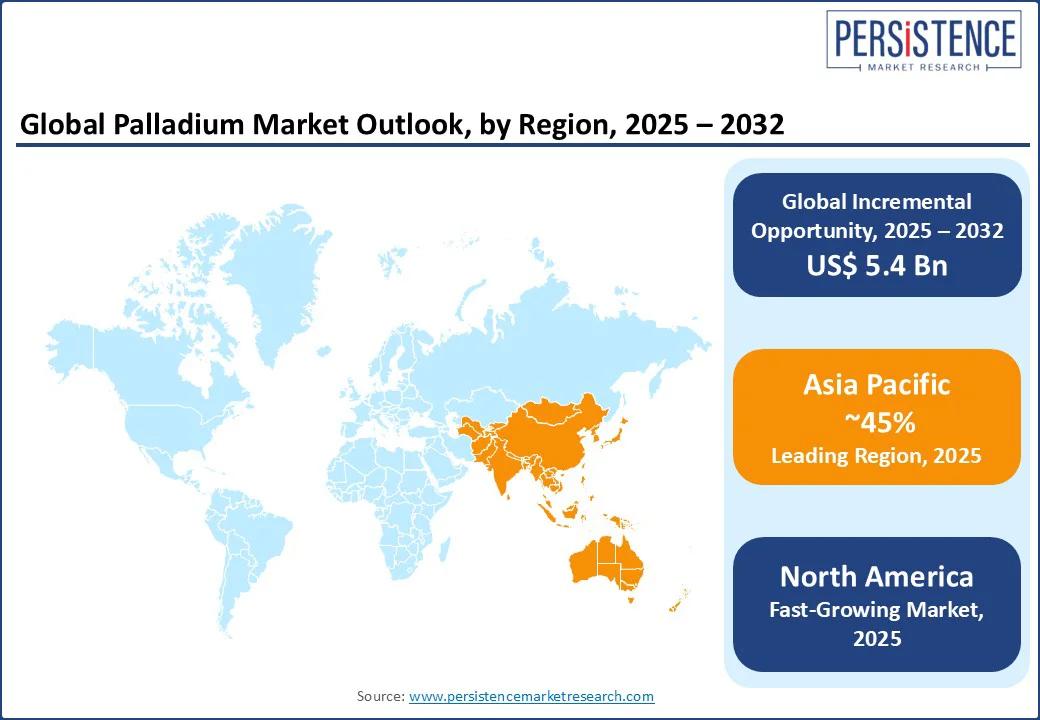ID: PMRREP4339| 188 Pages | 14 Aug 2025 | Format: PDF, Excel, PPT* | Chemicals and Materials

The global palladium market size is likely to be valued at US$ 15.1 Bn in 2025 and is estimated to reach US$ 20.5 Bn by 2032, growing at a CAGR of 4.5% during the forecast period 2025 - 2032.
The market is driven by automotive palladium and palladium jewelry. The supply chain and production by country, in catalytic converters, and fuel cell technology, are reshaping the industry. Investment opportunities in palladium bullion and coins, white gold alloy components, are gaining traction, supported by rising price volatility and demand for eco-friendly applications. The industry is further propelled by the growing adoption of rhodium and platinum substitutes in automotive applications, particularly in catalytic converters, and consumer interest in sustainable precious metals.

Key Industry Highlights:
|
Global Market Attribute |
Key Insights |
|
Palladium Market Size (2025E) |
US$ 15.1 Bn |
|
Market Value Forecast (2032F) |
US$ 20.5 Bn |
|
Projected Growth (CAGR 2025 to 2032) |
4.5% |
|
Historical Market Growth (CAGR 2019 to 2024) |
4.2% |
The palladium market is driven by several key factors, with a significant focus on stringent emission regulations and rising demand for automotive palladium. Global automotive production reached 85 million vehicles in 2024, per OICA, with 70% of gasoline vehicles equipped with catalytic converters containing Pd content in catalytic converters. Palladium’s superior catalytic properties make it a preferred choice over rhodium and platinum for reducing emissions, driven by regulations such as Euro 7 and EPA Tier 3, which mandate 30% lower emissions by 2025.
A 2025 study noted that palladium catalyst demand in catalytic converters grew by 15% annually, boosting the palladium market. The palladium supply chain and production by country, particularly in Russia and South Africa, supports this demand, with Norilsk Nickel supplying 40% of global palladium in 2024. Additionally, consumer interest in palladium jewelry and white gold alloy component drives 10% growth in jewelry manufacturing as palladium’s durability and aesthetic appeal complement precious metals markets. The palladium spot price forecast, predicting a 10% price increase in 2025 due to supply constraints, further fuels market growth, attracting investment opportunities in palladium bullion and coins.
Supply constraints and price volatility pose a significant restraint to the palladium market, impacting palladium price stability and availability. Palladium is primarily mined in Russia and South Africa, with 80% of global supply from these regions. Geopolitical tensions and labor strikes, particularly in South Africa, reduced palladium supply by 10% in 2025, per industry data, causing price spikes. The palladium spot price forecast indicates volatility, with prices fluctuating between US$ 1,800-2,200 per ounce in 2025, deterring cost-sensitive industries such as electronics and chemicals and petroleum. Recycling of palladium from spent catalytic converters, while growing, only accounts for 25% of supply, insufficient to offset mining disruptions. This scarcity challenges automotive palladium applications, as automotive OEMs face 15% higher input costs, limiting scalability in price-sensitive markets such as India and Latin America. Additionally, competition from platinum substitutes in fuel cell technology and jewelry manufacturing creates a diversion for organic growth.
The growth in fuel cell technology presents a significant opportunity for the palladium market, driven by palladium’s role in hydrogen storage and palladium catalyst applications. The global fuel cell market is projected to grow at a CAGR of 20% through 2032, per McKinsey, with fuel cell vehicles (FCVs) requiring palladium catalyst for hydrogen oxidation, boosting demand by 12% in 2025, per industry data. Companies such as Heraeus are investing US$ 300 million in R&D for hydrogen storage materials, enhancing fuel cell technology efficiency. Palladium’s high hydrogen absorption capacity makes it ideal for FCVs and stationary fuel cells, with Toyota and Hyundai integrating palladium catalyst in 10% of FCVs in 2025. The palladium supply chain and production by country supports this growth, with recycling of palladium from spent catalytic converters providing a sustainable source. Emerging markets, particularly in Asia Pacific, with 1.2 billion new vehicles projected by 2030, per OICA, offer opportunities for automotive palladium in fuel cell applications, positioning precious metal refining as a key growth driver.
Mined palladium holds approximately 75% of the market share in 2025 due to its dominance in the palladium supply chain and production by country, particularly in Russia and South Africa. Norilsk Nickel and Sibanye-Stillwater supplied 60% of mined palladium in 2025 supporting automotive palladium demand. Recycled palladium is driven by the recycling of palladium from spent catalytic converters. 25% of palladium supply came from recycling in 2025, fueled by sustainability initiatives.
Automotive commands a 60% market share in 2025, driven by Pd content in catalytic converters and automotive palladium for emission control. 70% of gasoline vehicles used palladium-based converters in 2025. Electronics is fueled by hydrogen storage materials and fuel cell technology, with 15% growth in palladium use for sensors and capacitors in 2025.

In North America, the Palladium Market holds a distinct position, commanding a 25% market share in 2025. The U.S. dominates due to its robust automotive industry and high demand for automotive palladium. The U.S. market is driven by Pd content in catalytic converters, with 80% of U.S. gasoline vehicles using palladium-based converters in 2025. Investment opportunities in palladium bullion and coins grew by 10% in 2025, driven by palladium price volatility. The automotive detailing industry and jewelry manufacturing also contribute, with palladium jewelry and white gold alloy components seeing 8% growth. Precious metal refining supports recycling of palladium from spent catalytic converters, with 30% of U.S. palladium sourced from recycling in 2025. Automotive OEMs such as Ford drive 20% of regional revenue, supported by stringent emission standards.
In Europe, the Palladium Market accounts for a 20% maarket share, led by Germany, the UK, and Russia. Germany’s market is driven by automotive palladium from Volkswagen and BMW, with 60% of vehicles using palladium catalysts in 2025. The EU’s Euro 7 regulations boost Pd content in catalytic converters, with 20% growth in 2025. The UK’s focus on fuel cell market supports with palladium catalyst adoption in FCVs. Russia’s role in the palladium supply chain and production by country, led by Norilsk Nickel, ensures supply stability. Palladium jewelry and precious metal refining grow by 10%, supported by €150 million in EU funding for green technologies in 2025.
Asia Pacific is the most prominent, likely to account for 45% market share, led by China, Japan, and India. China holds a 40% regional market share, driven by a 25% increase in vehicle production in 20225, per OICA, boosting automotive palladium and Pd content in catalytic converters. Japan’s market fueled by fuel cell technology and hydrogen storage materials, with Toyota integrating palladium catalyst in FCVs. India’s market is driven by palladium jewelry and white gold alloy component, with 15% growth in jewelry manufacturing in 2025. The recycling of palladium from spent catalytic converters and sustainable precious metal refining, supported by US$ 30 billion in automotive investments by 2030, drive innovation.

The global palladium market is marked by fierce competition, with mining and refining companies competing on supply chain efficiency, sustainability, and innovation. Norilsk Nickel and Sibanye-Stillwater dominate in mined palladium, while Heraeus leads in recycling of palladium from spent catalytic converters. Palladium catalyst, fuel cell technology, and palladium jewelry add a competitive layer. Strategic partnerships and investments in precious metal refining are key differentiators.
The palladium market is projected to reach US$ 15.1 Bn in 2025.
Stringent emission regulations and demand for palladium catalyst in automotive applications are key drivers.
The palladium market grows at a CAGR of 4.5% from 2025 to 2032, reaching US$ 20.5 Bn by 2032.
Opportunities include fuel cell technology, recycling of palladium from spent catalytic converters, and emerging market expansion.
Key players include Norilsk Nickel, Sibanye-Stillwater, Anglo American Platinum, Impala Platinum Holdings Limited, Vale S.A., Northam Platinum Holdings Limited, Ivanhoe Mines Ltd., Heraeus, Hindustan Platinum Pvt. Ltd., and Junsei Chemical Co., Ltd.
|
Report Attribute |
Details |
|
Historical Data/Actuals |
2019 - 2024 |
|
Forecast Period |
2025 - 2032 |
|
Units |
Value: US$ Bn, Volume: As Applicable |
|
Geographical Coverage |
|
|
Segmental Coverage |
|
|
Competitive Analysis |
|
|
Report Highlights |
|
|
Customization and Pricing |
Available upon request |
By Source
By End-use
By Region
Delivery Timelines
For more information on this report and its delivery timelines please get in touch with our sales team.
About Author